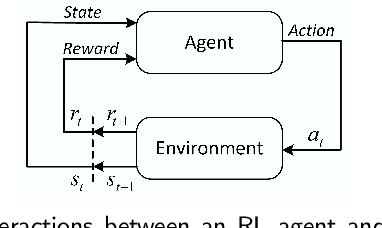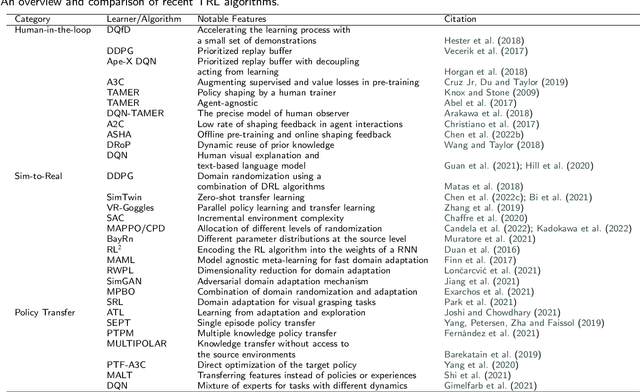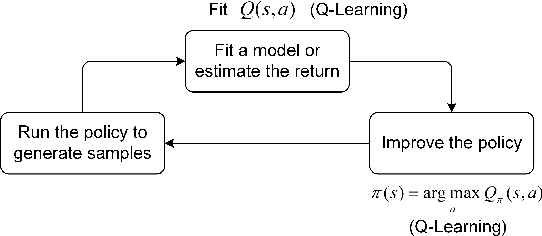Roozbeh Razavi-Far
Proxy-Anchor and EVT-Driven Continual Learning Method for Generalized Category Discovery
Apr 11, 2025Abstract:Continual generalized category discovery has been introduced and studied in the literature as a method that aims to continuously discover and learn novel categories in incoming data batches while avoiding catastrophic forgetting of previously learned categories. A key component in addressing this challenge is the model's ability to separate novel samples, where Extreme Value Theory (EVT) has been effectively employed. In this work, we propose a novel method that integrates EVT with proxy anchors to define boundaries around proxies using a probability of inclusion function, enabling the rejection of unknown samples. Additionally, we introduce a novel EVT-based loss function to enhance the learned representation, achieving superior performance compared to other deep-metric learning methods in similar settings. Using the derived probability functions, novel samples are effectively separated from previously known categories. However, category discovery within these novel samples can sometimes overestimate the number of new categories. To mitigate this issue, we propose a novel EVT-based approach to reduce the model size and discard redundant proxies. We also incorporate experience replay and knowledge distillation mechanisms during the continual learning stage to prevent catastrophic forgetting. Experimental results demonstrate that our proposed approach outperforms state-of-the-art methods in continual generalized category discovery scenarios.
Large Language Model (LLM) for Software Security: Code Analysis, Malware Analysis, Reverse Engineering
Apr 07, 2025Abstract:Large Language Models (LLMs) have recently emerged as powerful tools in cybersecurity, offering advanced capabilities in malware detection, generation, and real-time monitoring. Numerous studies have explored their application in cybersecurity, demonstrating their effectiveness in identifying novel malware variants, analyzing malicious code structures, and enhancing automated threat analysis. Several transformer-based architectures and LLM-driven models have been proposed to improve malware analysis, leveraging semantic and structural insights to recognize malicious intent more accurately. This study presents a comprehensive review of LLM-based approaches in malware code analysis, summarizing recent advancements, trends, and methodologies. We examine notable scholarly works to map the research landscape, identify key challenges, and highlight emerging innovations in LLM-driven cybersecurity. Additionally, we emphasize the role of static analysis in malware detection, introduce notable datasets and specialized LLM models, and discuss essential datasets supporting automated malware research. This study serves as a valuable resource for researchers and cybersecurity professionals, offering insights into LLM-powered malware detection and defence strategies while outlining future directions for strengthening cybersecurity resilience.
FedNIA: Noise-Induced Activation Analysis for Mitigating Data Poisoning in FL
Feb 23, 2025Abstract:Federated learning systems are increasingly threatened by data poisoning attacks, where malicious clients compromise global models by contributing tampered updates. Existing defenses often rely on impractical assumptions, such as access to a central test dataset, or fail to generalize across diverse attack types, particularly those involving multiple malicious clients working collaboratively. To address this, we propose Federated Noise-Induced Activation Analysis (FedNIA), a novel defense framework to identify and exclude adversarial clients without relying on any central test dataset. FedNIA injects random noise inputs to analyze the layerwise activation patterns in client models leveraging an autoencoder that detects abnormal behaviors indicative of data poisoning. FedNIA can defend against diverse attack types, including sample poisoning, label flipping, and backdoors, even in scenarios with multiple attacking nodes. Experimental results on non-iid federated datasets demonstrate its effectiveness and robustness, underscoring its potential as a foundational approach for enhancing the security of federated learning systems.
TrustChain: A Blockchain Framework for Auditing and Verifying Aggregators in Decentralized Federated Learning
Feb 23, 2025Abstract:The server-less nature of Decentralized Federated Learning (DFL) requires allocating the aggregation role to specific participants in each federated round. Current DFL architectures ensure the trustworthiness of the aggregator node upon selection. However, most of these studies overlook the possibility that the aggregating node may turn rogue and act maliciously after being nominated. To address this problem, this paper proposes a DFL structure, called TrustChain, that scores the aggregators before selection based on their past behavior and additionally audits them after the aggregation. To do this, the statistical independence between the client updates and the aggregated model is continuously monitored using the Hilbert-Schmidt Independence Criterion (HSIC). The proposed method relies on several principles, including blockchain, anomaly detection, and concept drift analysis. The designed structure is evaluated on several federated datasets and attack scenarios with different numbers of Byzantine nodes.
A Study on the Importance of Features in Detecting Advanced Persistent Threats Using Machine Learning
Feb 11, 2025Abstract:Advanced Persistent Threats (APTs) pose a significant security risk to organizations and industries. These attacks often lead to severe data breaches and compromise the system for a long time. Mitigating these sophisticated attacks is highly challenging due to the stealthy and persistent nature of APTs. Machine learning models are often employed to tackle this challenge by bringing automation and scalability to APT detection. Nevertheless, these intelligent methods are data-driven, and thus, highly affected by the quality and relevance of input data. This paper aims to analyze measurements considered when recording network traffic and conclude which features contribute more to detecting APT samples. To do this, we study the features associated with various APT cases and determine their importance using a machine learning framework. To ensure the generalization of our findings, several feature selection techniques are employed and paired with different classifiers to evaluate their effectiveness. Our findings provide insights into how APT detection can be enhanced in real-world scenarios.
Federated Continual Learning: Concepts, Challenges, and Solutions
Feb 10, 2025Abstract:Federated Continual Learning (FCL) has emerged as a robust solution for collaborative model training in dynamic environments, where data samples are continuously generated and distributed across multiple devices. This survey provides a comprehensive review of FCL, focusing on key challenges such as heterogeneity, model stability, communication overhead, and privacy preservation. We explore various forms of heterogeneity and their impact on model performance. Solutions to non-IID data, resource-constrained platforms, and personalized learning are reviewed in an effort to show the complexities of handling heterogeneous data distributions. Next, we review techniques for ensuring model stability and avoiding catastrophic forgetting, which are critical in non-stationary environments. Privacy-preserving techniques are another aspect of FCL that have been reviewed in this work. This survey has integrated insights from federated learning and continual learning to present strategies for improving the efficacy and scalability of FCL systems, making it applicable to a wide range of real-world scenarios.
Explainable Malware Detection through Integrated Graph Reduction and Learning Techniques
Dec 04, 2024Abstract:Control Flow Graphs and Function Call Graphs have become pivotal in providing a detailed understanding of program execution and effectively characterizing the behavior of malware. These graph-based representations, when combined with Graph Neural Networks (GNN), have shown promise in developing high-performance malware detectors. However, challenges remain due to the large size of these graphs and the inherent opacity in the decision-making process of GNNs. This paper addresses these issues by developing several graph reduction techniques to reduce graph size and applying the state-of-the-art GNNExplainer to enhance the interpretability of GNN outputs. The analysis demonstrates that integrating our proposed graph reduction technique along with GNNExplainer in the malware detection framework significantly reduces graph size while preserving high performance, providing an effective balance between efficiency and transparency in malware detection.
Towards Sample-Efficiency and Generalization of Transfer and Inverse Reinforcement Learning: A Comprehensive Literature Review
Nov 15, 2024



Abstract:Reinforcement learning (RL) is a sub-domain of machine learning, mainly concerned with solving sequential decision-making problems by a learning agent that interacts with the decision environment to improve its behavior through the reward it receives from the environment. This learning paradigm is, however, well-known for being time-consuming due to the necessity of collecting a large amount of data, making RL suffer from sample inefficiency and difficult generalization. Furthermore, the construction of an explicit reward function that accounts for the trade-off between multiple desiderata of a decision problem is often a laborious task. These challenges have been recently addressed utilizing transfer and inverse reinforcement learning (T-IRL). In this regard, this paper is devoted to a comprehensive review of realizing the sample efficiency and generalization of RL algorithms through T-IRL. Following a brief introduction to RL, the fundamental T-IRL methods are presented and the most recent advancements in each research field have been extensively reviewed. Our findings denote that a majority of recent research works have dealt with the aforementioned challenges by utilizing human-in-the-loop and sim-to-real strategies for the efficient transfer of knowledge from source domains to the target domain under the transfer learning scheme. Under the IRL structure, training schemes that require a low number of experience transitions and extension of such frameworks to multi-agent and multi-intention problems have been the priority of researchers in recent years.
Decentralized Federated Learning: A Survey on Security and Privacy
Jan 25, 2024Abstract:Federated learning has been rapidly evolving and gaining popularity in recent years due to its privacy-preserving features, among other advantages. Nevertheless, the exchange of model updates and gradients in this architecture provides new attack surfaces for malicious users of the network which may jeopardize the model performance and user and data privacy. For this reason, one of the main motivations for decentralized federated learning is to eliminate server-related threats by removing the server from the network and compensating for it through technologies such as blockchain. However, this advantage comes at the cost of challenging the system with new privacy threats. Thus, performing a thorough security analysis in this new paradigm is necessary. This survey studies possible variations of threats and adversaries in decentralized federated learning and overviews the potential defense mechanisms. Trustability and verifiability of decentralized federated learning are also considered in this study.
Learning From High-Dimensional Cyber-Physical Data Streams for Diagnosing Faults in Smart Grids
Mar 15, 2023Abstract:The performance of fault diagnosis systems is highly affected by data quality in cyber-physical power systems. These systems generate massive amounts of data that overburden the system with excessive computational costs. Another issue is the presence of noise in recorded measurements, which prevents building a precise decision model. Furthermore, the diagnostic model is often provided with a mixture of redundant measurements that may deviate it from learning normal and fault distributions. This paper presents the effect of feature engineering on mitigating the aforementioned challenges in cyber-physical systems. Feature selection and dimensionality reduction methods are combined with decision models to simulate data-driven fault diagnosis in a 118-bus power system. A comparative study is enabled accordingly to compare several advanced techniques in both domains. Dimensionality reduction and feature selection methods are compared both jointly and separately. Finally, experiments are concluded, and a setting is suggested that enhances data quality for fault diagnosis.
 Add to Chrome
Add to Chrome Add to Firefox
Add to Firefox Add to Edge
Add to Edge